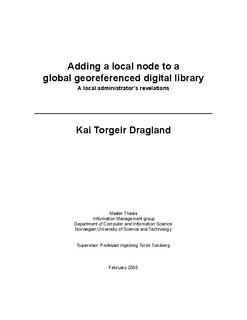| dc.description.abstract | Global digital libraries depend on the cooperation between many independent/autonomous organizations. The configuration of the local sub-systems in a global distributed digital library depends both on the requirements from the global system as well as from the local environments. The local administrators in the different organizations play a crucial and often neglected role in spreading global distributed digital libraries. The main goal of this thesis has been to add an operational local node, with local collections, to a global georeferenced distributed digital library network. The pilot installation was done with Alexandria Digital Library as the global georeferenced distributed digital library network, and Galleri Nor from the National Library of Norway was used as a local collection for the NTNU ADL node. The conclusions of this thesis have been reached through an investigation of theory concerning distributed georeferenced digital libraries and an investigation of problems and solutions associated with the pilot installation of the NTNU ADL node with Galleri Nor as the local collection. The main findings and recommendations from this work can be summarized as follows: 1. Digital libraries are characterized by the use of many different standards, formats, and technologies. This has an impact on the configuration of these systems. The complexity of digital libraries must be dealt with so that local administrators can install and configure digital library nodes without needing to be experts in all the different standards, formats, and technologies used in the digital libraries. A configuration tool can be used to add a layer of abstraction between the local administrator and the complexity of a digital library. Lowering the requirements of skills needed in order to install and configure a digital library with local collections can increase the expansion of the digital library technology. An increase in the number of nodes in a distributed digital library will most likely increase the number of available collections, and the increase of available collections will increase the value of the distributed digital library network for information seekers. As more information seekers realize the value of the distributed digital library network more organizations will seek to become part of such a global network. Addressing the problems the local administrators face in the configuration and installation process in order to make a more user-friendly system is the first step in the right direction on the path towards a global distributed digital library system. 2. Documentation must be written with a complexity and a terminology that can be easily understood by the user groups of the system. It is important to know for whom the documentation is written. The documentation is an important part of the puzzle for solving the problems related to the configuration of a digital library with local collections. In digital libraries, as in all other software systems, the user groups have to be identified. The documentation must meet the needs and use the right terminology at the right knowledge-level for each user group. Three user groups are identified in this thesis: software developers, local administrators, and information seekers. 3. It is possible to add existing Norwegian collections to a global georeferenced distributed digital library, and to make the local collections available for a global audience. One main difference between georeferenced digital libraries and digital libraries in general, is that georeferenced digital libraries provide new access points to collections where spatial literacy can be used to solve problems and satisfy information needs. The problems described in this thesis are not specific for global georeferenced digital libraries, but will affect all global digital libraries with distributed nodes in the same way. Existing Norwegian collections can be added to a global georeferenced distributed digital library network regardless of the content of the collection, or which metadata formats and standards used. The prerequisite of this thesis was to use the Alexandria Digital Library and add a collection from the National Library of Norway to the local NTNU ADL node. Galleri Nor was chosen as the collection from the National Library. The theory part of this thesis investigates digital libraries and what the georeferenced information paradigm offers in the context of digital libraries. The theory gives an overview of georeferencing in digital libraries and which technologies and problems associated with this relatively new paradigm. Special attention is given to the Alexandria Digital Library system. The possibilities this system offers are discussed in the ADL chapter. The State of the Art part of the thesis compares different georeferenced systems and investigates the concept of a fully fledged georeferenced digital library and how different systems compare to this concept. The Installation of the NTNU pilot system, Discussion, and Possible improvements and recommendations chapters give an overview of the installation and issues related to the installation and configuration of a local node (from a local administrator s point of view), and how these issues may be addressed through possible solutions and further work. | nb_NO |
